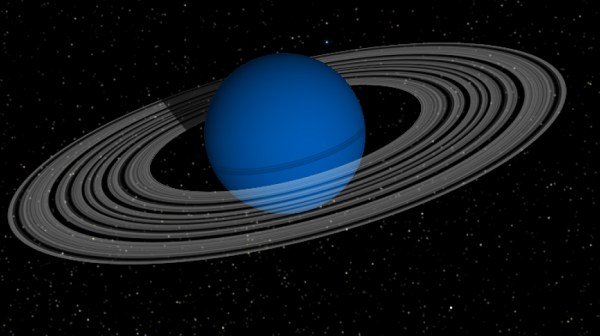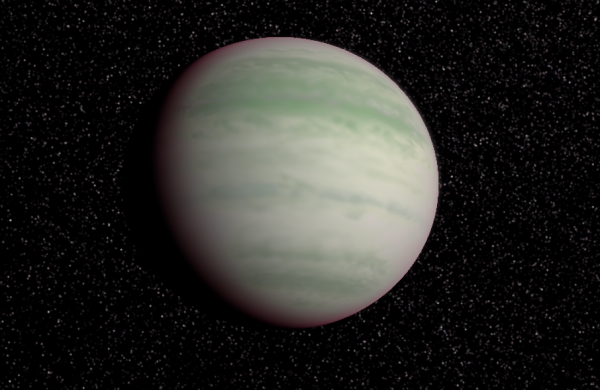BY LETTER
Neptunian Worlds
Also known as Ice Giant worlds | |
 Image from Steve Bowers | |
| Four different Neptunian worlds; a cold Methanean world, a temperate Mezoazurian world with some polar clouds, a Lapicaelian world with relatively little internal ice, and a Titan-like Aithalian with organic smog. | |
Introduction
Neptunian worlds are a major class of planet which are distinguished by an ice-rich composition, hence their alternative name 'Ice Giants'. These planets have a dense outer layer of atmosphere, overlaying a thick mantle of ices of various kinds, covering a relatively small core of rock and metals. These worlds can be distinguished from ocean worlds (Panthallassic type worlds) which have a relatively thin atmosphere, but in many ways ice giants and ocean worlds have many features in common. Neptunians are also distinguishable from terrestrial worlds and superterrestrials, which contain much less ice and are mostly rock or metals, and from gas giants, which contain much less ice as a fraction of their total mass.The dividing line between Gas Giants and Ice Giants is set at 50% H/He. Ice giants, especially Superneptunian worlds, often resemble gas giants on a superficial level, but if their mass consists of less than half hydrogen and helium they are placed in the Neptunian class.
General classification of worlds by Mass and Composition
It is useful to consider the mass and composition of planetary objects in order to compare the various classes, and in particular to distinguish Neptunian/ice giants from other worlds.TERRESTRIALS [0.04-2.5 x Earth's Mass, <0.1% H/He by mass] example: Earth, Venus, Mars
MICRONEPTUNIANS [<2.5 Me, 0.1-50% H/He by mass] example: Kepler-11b, Kepler-11f, Obele Ikuku, Fira
SUPERTERRESTRIALS [2.5-10 Earth's Mass, m <0.1% H/He] example: Seattle, Janssen
SUBNEPTUNIANS [2.5-10 Earth's Mass, m 0.1-50% H/He] example: Kepler-11c, 11d, 11e, 11g, Tartarus, New Luna, Mantis
HYPERTERRESTRIALS [>10 Me, m <0.1% H/He] example: BD+20594b, Moab
NEPTUNIANS [10-50 Me, m 0.1-50% H/He] example: Uranus, Neptune, Skoll, Iolus, Mt. Ranier
MICROJOVIANS [<50 Me, m >50% H/He] example: Stockholm, Bergen, Kepler-51d?
SUPERNEPTUNIANS [>50 Me, m 0.1-50% H/He] example: Saubarag, Smertrios, Adonis
SUBJOVIANS [50-150 Me, m >50% H/He] example: Saturn.
JOVIANS [150 Me - 4.5 Mj, m >50% H/He] example: Jupiter, Natasha
SUPERJOVIANS [>4.5 Mj, m >50% H/He] Pangu, Balor, Big Bob.
Subclasses of Neptunian worlds
Classification by atmospheric composition- EuNeptunian: Volatile dominated Neptunians with compositions similar to SolSys Neptune.
- Aithalian [from Greek αιθαλη; "soot"]: Neptunian worlds with interiors rich in hydrocarbons and carbon allotropes. Worlds of this kind are found in similar systems to Adamaean (carbon) terrestrials.
- Ydratian [from Greek υδρατμους; "water vapor"]: Neptunian worlds with H/He rich, but water dominated, atmospheres.
- Helian [from Helium]: Worlds with helium rich atmospheres.
- UltraHelian: Worlds that have helium dominated atmospheres.
- Lapicaelian [from Latin lapis caeli "stone air"]: Neptunian worlds with a primarily rocky interior.
- Skonian [from Greek σκονη; "dust"]: Rocky worlds with a shallow ice mantle and less than 10 kBar of H/He in the atmosphere. Worlds of this kind which have lost nearly all of their atmosphere may fall into the terrestrial, superterrestrial or hyperterrestrial classes.
- Pagonian [from Greek παγωνια "frost"]: Neptunian worlds a thick ice mantle, and less than 10 kBar of H/He in the atmosphere.
- Nebularian: H/He rich Neptunians with 40-50% of their mass in H/He.
 Image from Steve Bowers | |
| Cleo, a cold AzuriNeptunian world | |
Classification by Temperature
The temperature of a planet will determine the kinds of hazes and clouds that can form at the top of the atmosphere; this characteristic affects the appearance very significantly. The colours, cloud patterns and albedo of a world are indicators of the temperature and energistics of the visible layers.- CryoAzurian: Below 60 K. Too cold for methane clouds or organic hazes. Dark dull blue in color.
- Methanean: 60-80 K. Similar to the summer hemisphere of Uranus, with moderately dense methane clouds and organic hazes, resulting in a white-turquoise color.
- Ammonian: 80-180 K. Equivalent to eujovian gas giants (Sudarsky class I). Ammonia, ammonium hydrosulfide, and/or hydrogen sulfide clouds, under diffuse organic hazes. Dull yellow to light orange in color.
- Aquean: 180-320 K. Equivalent to hydrojovian gas giants (Sudarsky class II). Water clouds and little to no hazes. White in color, with variable amounts of blue in the depths.
- Vitrolic: 320-400 K. Subtype with sulfuric acid clouds with substantial sulfur aerosol hazes like Venus. Very similar in appearance to Aquean clouds. Light tan, white, or taupe in color.
- MesoAzurian: 400-650 K. Equivalent to azurijovian gas giants (Sudarsky class III). No high altitude clouds, but still possess a modest amount of sulfur aerosol hazes. Dull blue to teal in color.
- ChloroAlkali/SulfoMetalic: 650-850 K. Clouds primarily of potassium, rubidium, and cesium chlorides. At higher temperatures zinc and lead sulfides will also be present. Pale green to light bronze in color.
- SulfoAlkali: 850-1100 K. Equivalent to epistellar jovian gas giants (Sudarsky class IV). Lithium and sodium sulfide clouds giving a dark brown color. These worlds may be hot enough to radiate visibly on their night sides, depending on heat transfer.
- PyroAzurian: 1100-1400 K. Similar to azurian only hotter. Another significantly large gap between common cloud species resulting in a deep blue color due to an absence of any hazes.
-Erythronian: 1400-1700 K. clouds of vanadium oxide, chromium, manganese oxide and manganese sulfide. Dull red to dark orange in color. Hot enough for a titanium oxide haze to form.
- Mafician: 1700-2200 K. Same as hyperthermal gas giants. (Sudarsky class V). Clouds of silicon, magnesium, and iron oxides, and a titanium oxide haze. Light grey-brown in color. Named after rocks rich in iron and magnesium.
- Perovskian. Above 2200 K. Clouds of corundum and calcium titanate, with a TiO haze. Often resemble an L-Dwarf in color. Dull red-pink, with a wide variation in albedo depending on cloud density.
 Image from Steve Bowers | |
| Zynran, a ChloroAlkaliNeptunian world with alkali-chloride salt clouds | |
Related Articles
Appears in Topics
Development Notes
Text by Dangerous Safety
Initially published on 04 December 2019.
Initially published on 04 December 2019.






